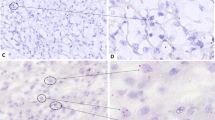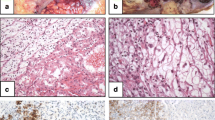Abstract
Purpose
To determine whether the type of VHL gene pathogenic variant influences the growth rate or CT enhancement values of renal lesions in VHL patients.
Materials and methods
Thirty-two VHL patients (19 male) were selected from a prospectively maintained imaging database for patients that underwent surgical tumor resection between 2014 and 2016. One hundred and eleven VHL lesions were marked for resection and pathology analysis. Whole lesion volumetric segmentation was performed on nephrographic phase of the two most recent contrast-enhanced CT scans before surgery. Intensity distribution curves were obtained from segmentations. A linear mixed model, accounting for within-patient correlations, was used to compare the growth and enhancement differences between different germline pathogenic variant types.
Results
There was no significant difference for the lesions’ total growth between different germline pathogenic variants (P value = 0.78). The median growth rate for all lesions was 1.7 cc/year (IQR 0.5, 3.9) with a baseline median size of 4.1 cm3 (IQR 1.7, 11.7). In complex lesions, the solid portion of the tumor demonstrated a higher growth rate (1.6 cc/year) than cystic portions (0.02 cc/year) which stayed relatively unchanged. Only one pathogenic variant (Splice donor) showed some levels of difference in its relative enhancement from other subtypes.
Conclusion
The type of germline pathogenic variant on the VHL gene does not affect the growth rate or CT enhancement values of renal lesions in patients with VHL. The absolute growth rate of these tumors may be used in the scheduling of follow-up studies.




Similar content being viewed by others
References
Choyke P, Glenn G, Walther M, et al. (1992) The natural history of renal lesions in von Hippel-Lindau disease: a serial CT study in 28 patients. AJR Am J Roentgenol 159(6):1229–1234
Lonser RR, Glenn GM, Walther M, et al. (2003) von Hippel-Lindau disease. Lancet 361(9374):2059–2067
Linehan WM, Lerman MI, Zbar B (1995) Identification of the von Hippel-Lindau (VHL) gene: its role in renal cancer. Jama 273(7):564–570
Chen F, Kishida T, Yao M, et al. (1995) Germline mutations in the von Hippel-Lindau disease tumor suppressor gene: correlations with phenotype. Hum Mutat 5(1):66–75
Gross DJ, Shuin JW, Seizinger B, Kley N, Olschwang S (1996) Germline mutations in the n Hippel-Lindau Disease (VrwL) gene in families from America, Europe, and Japan. Hum Mutat 8:348–357
Neumann H, Wiestler O (1991) Clustering of features of von Hippel-Lindau syndrome: evidence for a complex genetic locus. Lancet 337(8749):1052–1054
Gossage L, Eisen T (2010) Alterations in VHL as potential biomarkers in renal-cell carcinoma. Nat Rev Clin Oncol 7(5):277
Maher E, Yates J, Harries R, et al. (1990) Clinical features and natural history of von Hippel-Lindau disease. QJM 77(2):1151–1163
Duffey BG, Choyke PL, Glenn G, et al. (2004) The relationship between renal tumor size and metastases in patients with von Hippel-Lindau disease. J Urol 172(1):63–65
Goldfarb DA, Neumann HP, Penn I, Novick AC (1997) Results of renal transplantation in patients with renal cell carcinoma and von Hippel-Lindau disease1, 2. Transplantation 64(12):1726–1729
Crispen PL, Viterbo R, Boorjian SA, et al. (2009) Natural history, growth kinetics, and outcomes of untreated clinically localized renal tumors under active surveillance. Cancer 115(13):2844–2852
Choyke PL, Glenn GM, Walther M, et al. (1995) von Hippel-Lindau disease: genetic, clinical, and imaging features. Radiology 194(3):629–642
Kuo MD, Yamamoto S (2011) Next generation radiologic-pathologic correlation in oncology: Rad-Path 2.0. Am J Roentgenol 197(4):990–997
Sauk SC, Hsu MS, Margolis DJ, et al. (2011) Clear cell renal cell carcinoma: multiphasic multidetector CT imaging features help predict genetic karyotypes. Radiology 261(3):854–862
Karlo CA, Di Paolo PL, Chaim J, et al. (2014) Radiogenomics of clear cell renal cell carcinoma: associations between CT imaging features and mutations. Radiology 270(2):464–471
Balfe D, McClennan B, Stanley R, Weyman PJ, Sagel S (1982) Evaluation of renal masses considered indeterminate on computed tomography. Radiology 142(2):421–428
Bates D, Mächler M, Bolker B, Walker S (2014) Fitting linear mixed-effects models using lme4. arXiv preprint arXiv:14065823
Nielsen SM, Rhodes L, Blanco I, et al. (2016) Von Hippel-Lindau disease: genetics and role of genetic counseling in a multiple neoplasia syndrome. J Clin Oncol 34(18):2172–2181
Binderup MLM, Jensen AM, Budtz-Jørgensen E, Bisgaard ML (2017) Survival and causes of death in patients with von Hippel-Lindau disease. J Med Genet 54(1):11–18
Hoffman MA, Ohh M, Yang H, et al. (2001) von Hippel-Lindau protein mutants linked to type 2C VHL disease preserve the ability to downregulate HIF. Hum Mol Genet 10(10):1019–1027
Maher ER, Neumann HP, Richard S (2011) von Hippel-Lindau disease: a clinical and scientific review. Eur J Hum Genet 19(6):617–623
Ristau BT, Correa AF, Uzzo RG, Smaldone MC (2017) Active surveillance for the small renal mass: growth kinetics and oncologic outcomes. Urol Clin 44(2):213–222
Schraml P, Struckmann K, Hatz F, et al. (2002) VHL mutations and their correlation with tumour cell proliferation, microvessel density, and patient prognosis in clear cell renal cell carcinoma. J Pathol 196(2):186–193
Author information
Authors and Affiliations
Corresponding author
Ethics declarations
Conflict of interest
The authors declare no conflict of interest.
Ethical approval
All procedures performed in studies involving human participants were in accordance with the ethical standards of the institutional and/or national research committee and with the 1964 Helsinki declaration and its later amendments or comparable ethical standards.
Informed consent
Informed consent was obtained from all individual participants included in the study.
Funding
This work was supported by the Intramural Research programs of the Center for Cancer Research-National Cancer Institute and the National Institutes of Health Clinical Center, Bethesda, Maryland, USA.
Rights and permissions
About this article
Cite this article
Farhadi, F., Nikpanah, M., Li, X. et al. Germline VHL gene variant in patients with von Hippel-Lindau disease does not predict renal tumor growth. Abdom Radiol 43, 2743–2749 (2018). https://doi.org/10.1007/s00261-018-1540-1
Published:
Issue Date:
DOI: https://doi.org/10.1007/s00261-018-1540-1




